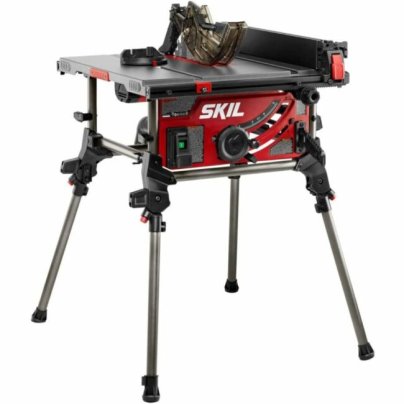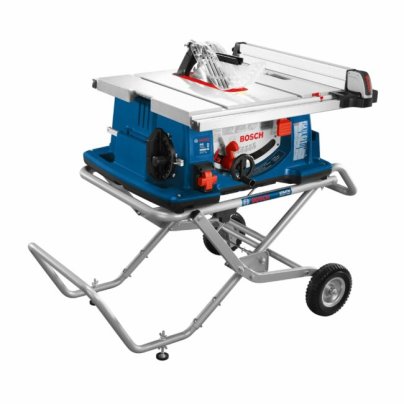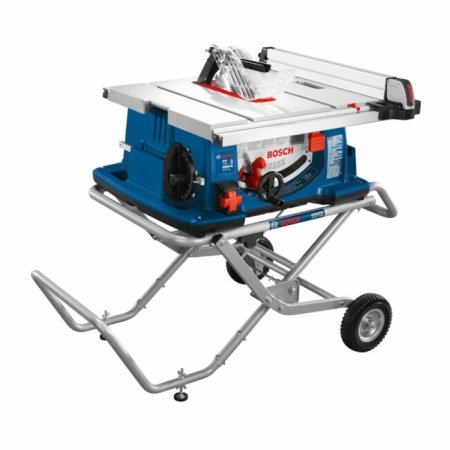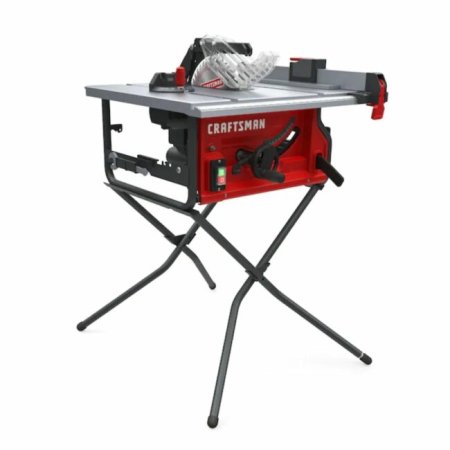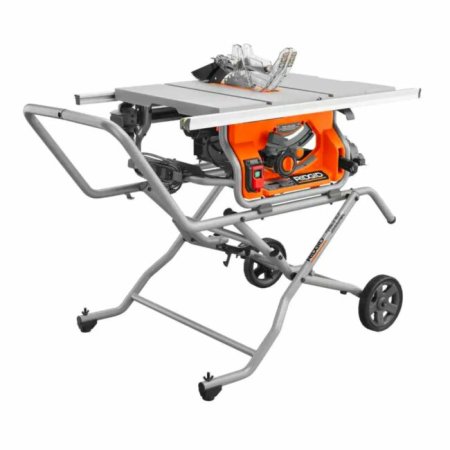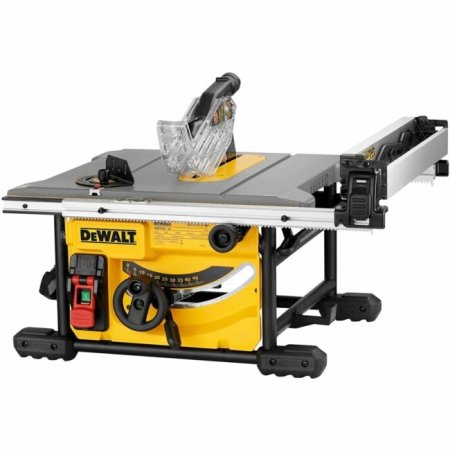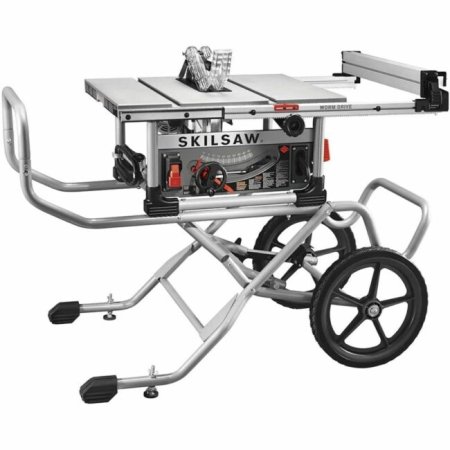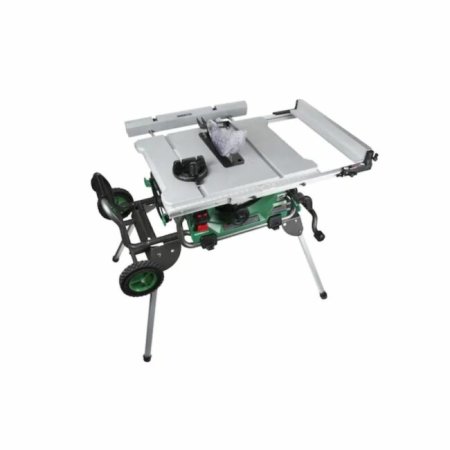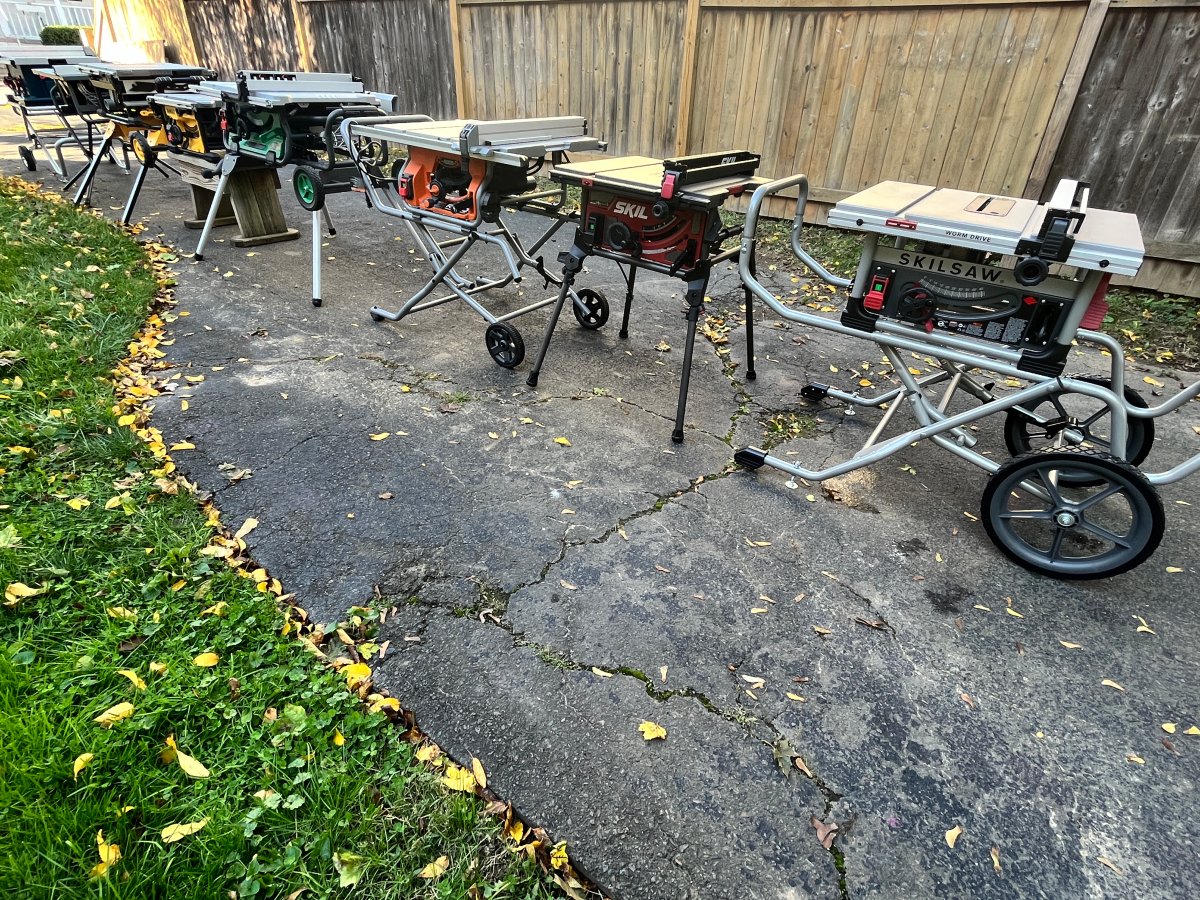
We may earn revenue from the products available on this page and participate in affiliate programs. Learn More ›
Table saws are a baseline necessity in many homes and professional workshops. Portable models are the go-to tool for everything from deck building to DIY tasks, from remodeling to woodworking, and from trimming a house to home repairs. While track saws are increasingly used for some traditional table-saw work (like breaking down sheet goods), the table saw is the best-suited tool for making wide boards thinner.
There are a lot of great choices out there, so it’s very likely that you can find a table saw that’s right for you and how you work. We took advice from industry experts who use table saws on a daily basis to help us build our list of recommendations. Keep reading to learn about the technical aspects of these versatile tools and find out how some of the best portable table saws currently on the market fared in our hands-on testing.
- BEST OVERALL: Skil 15-Amp 10-Inch Table Saw
- RUNNER-UP: Bosch Power Tools 10-Inch Worksite Table Saw
- BEST BANG FOR THE BUCK: Craftsman 10-Inch Table Saw
- BEST JOBSITE: DeWalt 10-Inch Table Saw, 32½-Inch Rip Capacity
- BEST WORKSHOP: Ridgid 10-Inch Pro Jobsite Table Saw with Stand
- BEST COMPACT: DeWalt 8¼-Inch Compact Jobsite Table Saw
- BEST HEAVY-DUTY: Skilsaw 10-Inch Heavy Duty Worm Drive Table Saw
- ALSO CONSIDER: Metabo HPT 10-Inch Table Saw with Fold and Roll Stand
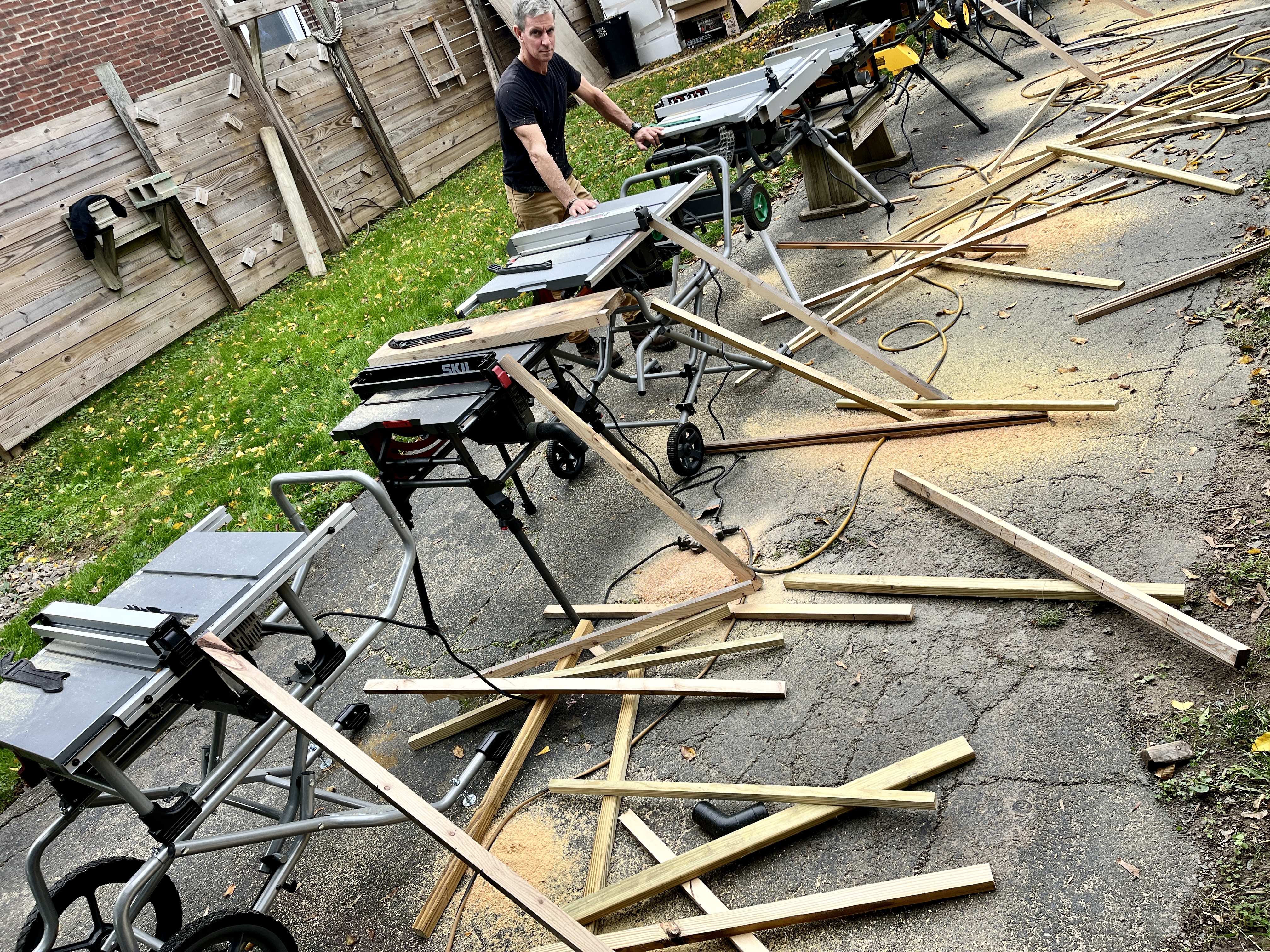
How We Tested the Best Portable Table Saws
To help bolster our research, we interviewed Ben Illig, a General Contractor and owner of Illig Properties in Pennsylvania, who has extensive hands-on experience with using portable table saws on jobsites. He says that “portability is more important than precision for a jobsite table saw. If more precision is needed, I would perform the work in an offsite woodshop with a more powerful and precise saw.” On talking about sought after features, he added, “”Easily adjustable and changeable blades are important, as well as an accurate table width that includes a built-in ruler.” We took this expert advice into consideration when lining up our favorite picks for testing.
We then tested these table saws with the occasional user, active DIYer, weekend woodworker, and professional user in mind. We looked at power, portability, switches, fence action, dust ejection, and the overall experience. While we have to pick a “best,” there is some subjectivity there. Each of the saws delivers on certain metrics for certain users, so even if a tool is not listed as the best on this list, it can still be best for certain users.
To test power, we took some dry Eastern white fir 2-by and ran it through each saw. We followed that up with some dry 2-by Hem-Fir framing, 5/4-pressure-treated Southern pine decking and typical 1-by. We looked at everything from how the saw started up to vibration during use to leg stands to how easy it was to fetch the push stick and how easy it was to shut the saw off. We also looked at stands, on-site mobility, stability, and how easily (or not) they would store in a shop or work truck.
- Portability: Obviously, a portable table saw’s ability to be moved is a key feature, and our selection represents each of the different transportation approaches.
- Cutting capacities: This list includes a range of tools that offer different capabilities, so there’s something for everyone, from weekend DIY enthusiasts to full-time professionals.
- Quality: While cheap portable table saws are available, this list includes only those brands with recognized reputations for durability and reliability. Some, however, are quite affordable.

Our Top Picks
The following picks are categorized, so potential buyers can quickly identify specific features. Each of the saws in the group had some standout features. We tested all of them, and here’s how we rated them.
Best Overall
Skil 15-Amp 10-Inch Table Saw
Product Specs
- Blade size: 10 inches
- Maximum rip: 25½ inches
- Weight: 51 pounds
This Bob Vila Approved product carries our brand’s highest level of recommendation.

Bob Vila Approved recognizes the household and DIY products that impressed us most in our real-world testing and that exemplify core values of the Bob Vila brand, including craftsmanship, innovation, and value for the dollar. Winners of this designation come recommended by our professional review team and are personally approved by Bob Vila.
What We Like
- Excellent and large cutting capacities allow the saw to do a variety of cuts
- Accurate rack-and-pinion fence makes setting up a cut easy
- Integrated stand for easy, on-site setup that saves time in the field
What We Don’t Like
- Low-quality included blade might not cut it for some users
- Power switch takes some getting used to
Out of the box, the saw was ready to go. The built-in leg kit worked great. It did require laying the saw on one side to extend or fold away the legs, but it was easy to do. The angle of the legs was stable and worked as a great base for heavy work like ripping framing or deck boards.
The rack-and-pinion fence was parallel to the blade out of the box, and it has a good cut capacity at 25½ inches to the right of the blade if breaking down sheet goods or making shelves. The crank-to-blade-movement ratio felt like the best of the bunch because it’s easy to attain a precise setup for a cut. It also has a simple, incredibly effective 45-degree attachment for the dust chute. This enables the user to direct sawdust—even more important for cutting inorganic material like composite decking or PVC—into a box or bucket. We found it to be a simple but awesome feature.
While the saw performed well in all materials tested, the unit was also terrific when not in use. The legs fold down such that the saw is a cube. We think this would be great on a work truck or in a crowded shop. There was very little to snag or catch, and the tool could be stored out of the way. The locking throat plate also stayed in place during transport, which wasn’t the case with other saws. The only downsides that we found were that the switch took some getting used to and the included blade could be better quality, but a simple blade change to a preferred saw blade is an easy update. Otherwise, this saw is well-designed and extremely capable.
Get the Skil portable table saw at Amazon, Lowe’s, Acme Tools, or Menard’s.
Runner-Up
Bosch Power Tools 10-Inch Worksite Table Saw
Product Specs
- Blade size: 10 inches
- Maximum rip: 30 inches
- Weight: 94 pounds
What We Like
- Very good quality and smooth cutting of multiple types of materials
- Excellent stand mechanism that is more stable than other portable table saws
- Maintains speed under hardworking load, like when cutting tough materials
What We Don’t Like
- Expensive when compared to other portable table saws
- Somewhat heavy and cumbersome to store
For frequent users, this table saw delivers. We found that its soft start was plush without it being so soft that we felt like we had to wait for the blade to get up to speed. We also liked how easily the fence glided on its rails without catching. Plus, the cut capacity was terrific, and we thought the cord wrap on the rear of the tool was an excellent added feature.
However, this portable table saw is big. While the collapsing wheeled stand worked nicely and the saw was easy to move on its pneumatic tires, it would be heavy for one person to maneuver in and out of a truck or between floors of a house, which most pro users have to do. That said, it is not a big deal for a pro to have more than one person on a jobsite.
At about 30 inches wide and 38 inches deep, the stand and saw size might make storage an issue for some users. It takes up a big chunk of the truck and a decent amount in the shop. In testing, we also noticed that the open frame and wheels liked to catch extension cords and other supplies, which could also pose a bit of a hassle to users.
For shops or sites where the saw will be set up for long periods of time or for those looking to up their woodworking or home improvement game, this saw is fantastic from the ground up.
Get the Bosch portable table saw at The Home Depot.
Best Bang for the Buck
Craftsman 10-Inch Table Saw
Product Specs
- Blade size: 10 inches
- Maximum rip: 12 inches
- Weight: 58 pounds
What We Like
- Same depth of cut as more expensive machines
- Roll cage protects motor and increases durability
- Good value for the money with essential features for most DIY projects
What We Don’t Like
- Modest ripping capacities at just 12 inches limits types of cuts
- Miter gauge may be a poor fit
The Craftsman brand has long been recognized for reliable, good-value-for-the-money tools, and this 10-inch portable table saw is no exception. For a modest price, this Craftsman table saw offers the same depth of cut as many more expensive saws: 3⅛ inches at 90 degrees and 2¼ inches at 45 degrees.
However, it saves cost in its ripping capacity. The table saw lacks an extending fence, which provides just 10 inches to the left of the blade and 12 inches to the right.
Yes, its detachable stand folds flat for compact storage; however, it is bolted on during setup and it’s not easily detached. The reality is that most users would store it with the stand on. It provides reasonable support for most typical cuts, like when cutting 1-by. When large pieces are used without any back-feed support, it flexes a little. Overall, we found that this saw was not designed for heavy-duty cutting of dense materials. It is, however, a budget-friendly pick that’s great for light-duty projects.
Get the Craftsman portable table saw at Lowe’s.
Best Jobsite
DeWalt 10-Inch Table Saw, 32½-Inch Rip Capacity
Product Specs
- Blade size: 10 inches
- Maximum rip: 32½ inches
- Weight: 110 pounds
What We Like
- Excellent capacities with a 32½-inch rip maximum
- Incredibly stable stand thanks to well-designed legs
- Excellent fence with push-stick storage that’s handy
What We Don’t Like
- Miter guide is small and flimsy
- Heavier than some other good-quality table saws
The DeWalt 10-inch Table Saw offers a combination of jobsite toughness, good capacity, and the potential for precise accuracy, all of which make it a popular choice with trade professionals. Like most table saws, it’s fitted with a general-purpose 24-tooth carbide-tipped blade. The maximum depth of cut at 90 degrees is 3⅛ inches; at 45 degrees, it’s 2¼ inches. Its ripping capability is 22 inches to the left of the blade and a class-leading 32½ inches to the right. The sturdy extending fence works on a precise rack-and-pinion track.
In testing, we found that this was the most stable saw in the bunch, with an aggressive leg flare that would make tipping this thing over while cutting long, heavy stock nearly impossible. But it didn’t take up any more of a footprint than the other saws in the group. Thanks to the saw’s folding legs and a modest wheel kit, we were able to break down and store this saw more easily than others. However, at 110 pounds, it was still heavy for one person to move.
The included construction-grade blade was terrific. The rack-and-pinion fence worked smoothly and it locked securely. The push-stick storage on the fence is a nice feature. Unlike some saws that sound like they are working hard, this saw displayed excellent power and smooth performance throughout testing on Eastern white fir 2-by, 2-by Hem-Fir framing, 5/4-pressure-treated Southern pine decking, and typical 1-by.
There’s little to criticize about this table saw. However, while the wheeled cart provided very good stability, it makes it heavier than some. The miter guide is flimsy and small, and this less-than-great feature doesn’t match the rest of the machine. Its price may also put it beyond the range of some DIY users.
Get the DeWalt 10-inch portable table saw at Amazon, The Home Depot, or Lowe’s.
Best Workshop
Ridgid 10-Inch Pro Jobsite Table Saw with Stand
Product Specs
- Blade size: 10 inches
- Maximum rip: 30 inches
- Weight: 95 pounds
What We Like
- Slightly better price point than comparable saws
- Decent power for cutting most typical types of material
- Mobile stand is helpful to move around the heavy table saw
What We Don’t Like
- Heavy for 1 person to move alone
- Felt resistance while cutting white fir
The Ridgid Jobsite Table Saw with the utility folding wheeled stand has professional cut capacity and features but with a more DIY-friendly price point. It cuts everything the other units cut and doesn’t break the bank.
With a 30-inch cut capacity; a solid, stable wheel kit; and a nice included blade, this saw took on all but the hardest materials we had (dry, Eastern white fir) without complaint. We felt some resistance when we were running the fir through this saw. It sailed through pine decking and 1-by material.
Some of the operational details were a little rougher than other saws in the group. If we didn’t push the fence just right to readjust it, it would stick, requiring two hands to unstick it. It works, but this extra step involved two hands and added time to adjust and check for each cut. The push stick was also a little gummy trying to get it out, but this may loosen up over time. The push stick itself, however, was nice and beefy.
It has a soft start, but it seemed to take about a three count for the blade to reach max rpm. For occasional use, this would be just fine. However, if one is using the saw all day, those seconds add up.
Get the Ridgid portable table saw at The Home Depot.
Best Compact
DeWalt 8¼-Inch Compact Jobsite Table Saw
Product Specs
- Blade size: 8¼ inches
- Maximum rip: 24½ inches
- Weight: 53 pounds
What We Like
- Good capacities at 24½-inch rip maximum for a compact saw
- Roll cage helps with extending jobsite durability
- Comparatively light saw for the portable table-saw category
What We Don’t Like
- No included stand means a table or stand needs to be purchased or built
The 8¼-inch table saw platform might seem counterintuitive to some users, but even though the blade is smaller than the standard 10-inch tools, in testing it cut 99 percent of what the bigger saws cut: 1-by and 2-by material, trim, and decking. It’s small and light, and the included blade is outstanding. The fence is the DeWalt-innovated rack and pinion with onboard push-stick storage and was parallel to the blade out of the box.
Because this is a smaller frame and there is no included stand, the saw is light and easy to carry, maneuver, and store. This is ideal for life on a truck or in a crowded shop, garage, or site.
However, there is no included stand, and table saws need stands for safe operation. A stand—whether purchased from DeWalt or custom-made in a workshop—would only make this fantastic saw more fantastic.
Get the DeWalt 8¼-inch portable table saw at Amazon, The Home Depot, or Lowe’s.
Best Heavy-Duty
Skilsaw 10-Inch Heavy Duty Worm Drive Table Saw
Product Specs
- Blade size: 10 inches
- Maximum rip: 30½ inches
- Weight: 93 pounds
What We Like
- Excellent cutting capacities at just more than 30-inch rip maximum
- Stable stand makes it easy to set up safely
- Go-anywhere wheels increase ease of maneuverability
What We Don’t Like
- Relatively bulky size limits the ease of moving it up a flight of stairs
- Premium price stretches it beyond an occasional DIY user with a limited budget
This Skilsaw is the only worm-drive unit in the category and is built on the legendary, never-say-die Skil “77” motor platform. There are all kinds of Ford-vs.-Chevy types of debates around worm-drive tools compared to direct-drive tools (like all of the other tools on this list).
While our observations may not steer those conversations, let’s just say that we see no power or durability difference with the worm gear. However, what we do see are nuances and details that make this saw worth considering, especially for frequent users like remodelers, deck builders, and other pros who use a saw for hours on end.
It blasted the fir we ran through it. Decking was a walk in the park. It also has a great crank-to-blade-movement ratio. And, the worm gear gave it a built-in soft start that is plush without a lag time. The tool was smooth. Like the Skil table saw on this list, it also has a 45-degree attachment for the dust chute. Again, this allows the user to direct sawdust easily into a box or bucket. As with the Skil, we found it to be a simple but very effective feature.
However, it is heavy. A one-person move up the stairs or out of the truck is a lot. The stand is great, but it is big and ungainly, both on-site and in storage. Solve for those variables, and this saw is a monster.
Get the Skilsaw portable table saw at Amazon, Lowe’s, or Acme Tools.
Also Consider
Metabo HPT 10-Inch Table Saw with Fold and Roll Stand
Product Specs
- Blade size: 10 inches
- Maximum rip: 35 inches
- Weight: 96 pounds
What We Like
- Excellent ripping capacities at 35-inch max makes this saw able to handle more types of cuts
- Smooth-cutting 40-tooth blade is included
- Excellent folding legs are easy to set up and break down
What We Don’t Like
- Could use more power to reduce the laboring sounds while cutting
- Material support needs to be used cautiously
There is a lot to like about the Metabo HPT 10-inch table saw. The folding legs and wheel kit make the unit both compact and mobile for a full-size saw. The fence adjustment works like a charm, and the fence was parallel with the blade out of the box. The included blade seems to be of high quality.
However, the unit chattered noticeably, cutting both white fir and Hem-Fir 2-by and even 5/4 Southern pine decking. It cut it like the other saws in the group, but the saw felt it. The saw has an extension arm for helping with long rips, and it works, but (a) only a little and (b) only for light material like siding and maybe composite decking.
If all that’s run is finger-joint primed trim, composite decking, siding, and the like, this saw does all of the table-saw things well. It has a nice stand, compact-ish storage, and a nice soft start. However, if horsepower is needed—we even changed the blade to a newly resharpened blade to make sure it wasn’t the blade holding it back—we found this saw is better suited to trim work and composite materials.
Get the Metabo portable table saw at Lowe’s or Acme Tools.
Jump to Our Top Picks
What to Consider When Choosing a Portable Table Saw
Some table saws, like contractor saws and cabinet saws, are intended mainly for shop use. The portable table saw is a category of tools that is referred to as “benchtop” in the industry, even though these tools are no longer designed to be used on a workbench. They are built to strike a balance between being portable and stable while dishing out enough power to work well in a backyard, in a garage, or on a jobsite. The following section discusses the key features that often impact choice.
Types of Portable Table Saws
Portable table saws can be divided into three main types: saws only, saws with leg kits, and saws with collapsible stands. Some models combine both legs and wheels. While some table saws are heavy, some stands can also be quite large and heavy without the saw, making the saw with stand even heavier and harder to handle. In some cases, moving it up a flight of stairs, getting it on and off a truck, or storing it out of the way in a home workshop or work truck can be tough. With that in mind, it’s important to balance saw power and size needs with portability needs.
Table Saw Only
Table saws without a base are the most compact and easy to store in a shop or truck. Their main drawback is that they need some kind of safe, stable bench to be used correctly. Using a table saw on the floor is neither practical, safe, nor productive. For example, if a user is set up on a driveway and must crouch down to cut, that’s a safety problem.
Table Saw with Leg Kit
Table saws with leg kits usually have legs that lock with a ball catch or similar positive stop. Some are integrated into the structure of the saw, while others are assembled and bolted on after setup.
Table Saw with Collapsible Stand
A collapsible stand is helpful for larger or heavier saws that need to be moved often. However, table saws with a collapsible, wheeled stand are arguably the most convenient, especially on heavier models that otherwise would be difficult to maneuver without help.
Cutting Power and Performance
Most portable table saws contain a 15-amp motor and can be plugged into any 120-volt outlet. A few models have overload protection to prevent damage to the motor, but more realistically this may minimize tripping breakers and slowing work. Some units have a “soft-start” feature, which gradually ramps up blade speed and is intended to make using the tool more comfortable. A few have a load-compensating feature called “electronic feedback control,” making them capable of ramping up power if the blade starts to bog down.
Blade speed runs from around 3,500 to 5,000 revolutions per minute (rpm), though in real terms, this makes little difference. Portable table saws primarily have a 10-inch blade. Also, smaller but very nice 8¼-inch-blade models can make most of the cuts the larger saws make.
Saw Stability
Stationary workshop saws have cast-iron tables that are dead flat, heavy, and very stable. This is ideal for working rough-sawn lumber or breaking down sheet goods. Some models have the rip capacity to make wide cuts in plywood or oriented strand board, for example, but care should be taken in setting up the saw so that it is on a stable surface without wobbling (and won’t tip over) and that the work is supported for a clean, safe cut. Don’t just run a sheet of ¾-inch medium-density fiberboard through the table saw because a unit has a wide cut capacity. It doesn’t work that way.
Easy Setup and Adjustments
The convenience of a good portable table saw depends to a large extent on its ease of transport. For many users, this is ideally a single-person job. Folding leg stands require the user to lie the saw on one side so the legs can be deployed. Not really a big deal. Rolling stands can arguably be set up quicker, but they are much, much larger and take up space on a crowded jobsite or in a truck.
Adjusting blade height and bevel angle should also be considered. In everyday practice, a table-saw blade rarely travels up or down much more than an inch or two—say between 1-by and 2-by thickness material. However, every so often the user has to crank the blade way up or way down to rip a 4-by or make a post cap, and it’s nice when it doesn’t feel like it will take a month to adjust the blade. Small details like this also often indicate that the overall tool design is well thought through.
Height adjustment is something most often done just within an inch or two, and it is the crank-to-blade-movement ratio, which describes how precise a table saw’s blade can be adjusted for an intended cut by using the built-in crank. Is this critical? No. But it’s nice when the ratio moves the blade with minimal cranks. Also, look at the tool’s measurement scales to make sure the increments are clearly marked. Many pro users don’t rely on the tool’s imprinted scales; there are lots of reasons for this. Instead, they use their tape measures to measure from the fence to a blade tooth.
Fence
The fence, or rip fence, keeps the wood parallel to the blade. It is critical for good, safe performance that the fence be parallel to the blade. The maximum distance from the blade to the fence defines the widest cut possible, which is called “rip capacity.” While removing the fence is possible, using a table saw without one is unsafe.
On some portable table saws, the fence slides on rails with a quick-release clamp to hold it in the desired position. The DeWalt-innovated rack-and-pinion system uses an under-mount knob and lever lock to adjust the fence.
In addition to the fence, table saws come with a miter gauge. Rarely used outside of woodworking (and even then, woodworkers swap it out for a crosscut sled or other jig), it can be used for cutting angles with the table saw. The heavier duty the gauge is, the better it is.
Dust Collection and Safety Features
All table saws have a dust port exiting the back of the saw. It can be connected to dust collection, like a shop vacuum, however, most just shoot straight out. A few models have a 45-degree elbow that can channel the sawdust into a box or bucket.
All portable table saws sold in the United States must have a blade guard and a riving knife or splitter to protect the safety of users. The riving knife is a steel plate that sits behind the blade to stop the cut from closing around the blade, which can shoot the workpiece back into the user.
Anti-kickback pawls that rest on top of the wood prevent kickback. Some pros say that these safety features create at least as many problems as they solve and say that using smart, sensible practices is the best way to work safely.
That said, there are at least two safety features that many DIY users appreciate: an obvious stop button and push stick. A portable table saw needs to have a prominent stop button so it’s easy to turn off. Another must-have is an easy-grab, stout push stick to guide the workpiece safely through the saw when making sliver cuts (anything under 1½ inches wide).
Tips for Using a Portable Table Saw
Although most people probably want to start working right away when their new portable table saw arrives, even experienced users need to read the manufacturer’s instruction manual. Failure to do so may mean they don’t maximize the potential of their saw. For any model, some one-size-fits-all safety tips to keep in mind when using a table saw include:
- Always wear appropriate safety gear: a dust mask, safety glasses or goggles, and ear protection.
- Keep hands well away from the blade. Whenever practical, use a push stick to guide the material.
- Always unplug the saw before making adjustments to the blade.
- Follow the old woodworker’s adage to “measure twice and cut once.”
- Double-check the saw setup to increase accuracy and reduce waste.
- The fence is for ripping, and it’s not sturdy enough to provide sufficient support for crosscutting. Use a miter gauge set at 90 degrees to the blade.
FAQs
If questions remain about choosing the right portable table saw, keep reading to find answers to some of the most commonly asked questions about these tools.
All the portable table saws in this list have good fences, but DeWalt’s 10-inch portable table saw’s rack-and-pinion fence is both sturdy and accurate.
At 46 pounds, the DeWalt 8¼-inch portable table saw is the lightest of the models available, but it’s a benchtop unit. At 51.2 pounds, the Skil portable table saw is the lightest with a stand or legs.
Using a high-speed blade always presents some risk of an accident, but if operated properly with the guard in place at all times, a table saw is not a dangerous tool.
Additional research provided by Mark Clement.
